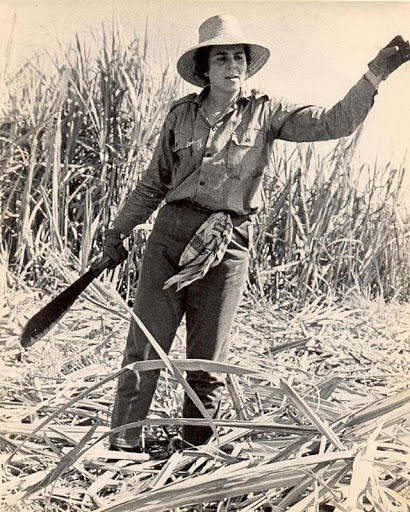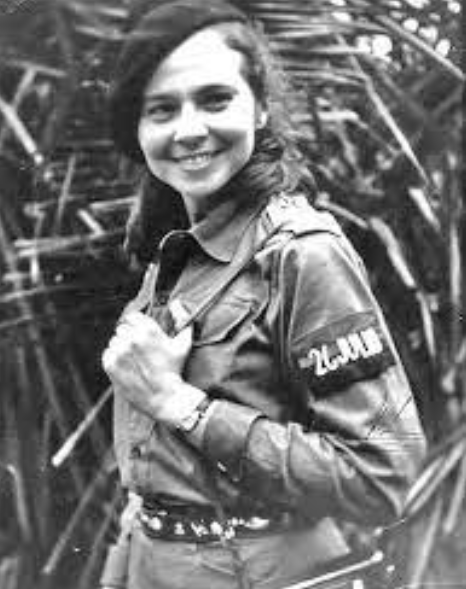
Vilma Espín, born April 7th, 1930, the Cuban Revolutionary whilst studying chemical engineering in her home country, she got involved in the student activist movement – organising a resistance to the 1952 coup led by Fulgencio Batista that put a stop to the then left-wing party from winning the election in Cuba. The turbulence and tyranny in Cuban society soon accelerated, with Batista massacring the Cuban people and assassinating the students of the burgeoning movement.
Espín’s wealthy lawyer father sent her to study chemical engineering in America at MIT, to dissuade her from being caught up in socialist activist work. Pressured into a way of life, she kept in touch with the people pushing for revolution that she had been organising around back home in Cuba.
On June 1956, Espin went to Mexico to meet with Fidel Castro after doing the initial underground work to set up the 26th of July Movement. She offered up her home back in Santiago for organizing the armed uprising of November 30th whilst she was still a student. Her home later became the headquarters of the movement in the region.
The uprising of the 26th of July Movement soon took place against the Batista government and their allies in the Mafia and the U.S. ruling class. Vilma Espín readily left for her homeland to fight along with the guerrillas in the Sierra Maestra – and struggle for a socialist revolution against the poverty, exploitation, chauvinism and racial discrimination that she had been raised around.
During the period of armed struggle, Vilma Espín was a part of the Mariana Grajales Women’s Platoon named after the Cuban patriot known as the – “mother of the country”. Mariana Grajales Cuello had fought for a independent Cuba free from slavery and an end to women’s oppression decades previously.
When the Revolution eventually triumphed in 1959, Vilma Espín had built up the early foundations of the Federation of Cuban Women. The Organization would work tirelessly to wither away at the discrimination women faced within Cuban society, and to mobilize around the economic changes that marginalized women from many parts of life on the island.
The Revolutionary Government radically transformed the country through the Agrarian Reform Law and the nationalization of the country’s sugar mills, the Urban Reform Law, the nationalization of the banks, foreign industries, and capital. The upheaval of the social bases of Cuban society freed people up off from centuries of persecution and discrimination they faced.

“Before the revolution there were ten thousand unemployed teachers. They weren’t working in any school. But immediately after January 1st, these ten thousand teachers weren’t nearly enough to meet our needs.”
In pre-Revolutionary Cuba, only 55% of children aged 6 to 14 were enrolled in school. Similarly, 22% of the Island’s population were illiterate, with women making up the large majority.
In 1961, a Campaign was launched to help breakdown the inequality surrounding education present across the Island. With a focus specifically on eradicating illiteracy, the Revolutionaries built up 10,000 primary schools in a single year – more than had been built during the previous 60 years of the Neo-colonial Republic.
More than 700,000 people, 55% of whom were women, became literate within twelve months, while illiteracy was slashed from 22% of the Cuban population down to 3.8%. This led UNESCO to declare Cuba to be the first ‘first territory free of illiteracy’, in 1961.
During 1961, the Federation of Cuban Women helped open up state-funded daycare facilities – in order to take the pressure of working mothers and free them up to contribute to the new Cuban society.
Vilma Espín said in a speech –
“When I talk about how the federation was created, I always emphasise that at the time we didn’t talk about women’s liberation. We didn’t talk about women’s emancipation, or the struggle for equality. We didn’t use those terms then. What we did talk about was participation. Women wanted to participate. This included women who had taken an active part in the struggle, who had been in the mountains. They, like other women across the country, wanted to help in this new stage that was dawning, which was a genuine revolution. …
Women had confidence in the revolution — because there was real proof, every day, that the revolution wasn’t just hot air, it wasn’t empty phrases of the kind people were used to hearing from politicians in the past. This was the genuine thing. And women wanted to be part of it, to do something. The more the revolutionary laws strengthened this conviction, the more women demanded a chance to contribute — and the more they saw how necessary their contribution was.”
In Pre-revolutionary Cuba, women constituted just 6.2% of the country’s middle, upper-level technicians and professionals (teachers, doctors, engineers, researchers, etc.) and civil servants (1959). Due to the tireless work of the Federation of Cuban Women, women now make up 66% of job roles they were previously marginalized from.
Whilst nations throughout the world leave things up to fate, Cuba takes the initiative by ensuring through law that the salaries of women who do equal work are strictly equivalent to those of men within Cuban society.
A necessary, and vital upheaval by the Cuban Revolutionary Government was the legalization of abortion in 1965, the first country in Latin America to make that social change. Since then, only four other countries in the continent (Guyana in 1995, Uruguay in 2012, Chile in 2017 and Argentina 2020) have followed in the Cuban peoples footsteps to bring about abortion rights.
Vilma Espín left her mark on this world, and left it a better place. Millions can be thankful to her, for her historic role as a revolutionarily who saw injustice, and took to the actions to bring an end to it.
Following in her mother’s tradition, Espín’s daughter Mariela Castro Espín is currently the director of Cuba’s National Center for Sex Education, and campaigns for the LGBTQ community in Cuba. With discrimination and aspects of social stigmas still existing on the Island, Mariela Castro Espín forms a open vocal opposition to injustices within certain struggles and aspects of life in Cuba.
The Federation of Cuban Women that Vilma Espín founded turned 60 years old in 2020. It currently has 4 million members, and has played a historic role in reshaping a society to be more inclusive and participatory for everyone across Cuba.
“What did the triumphant revolution offer our women? A new life, filled with possibilities and prospects, in which their deepest dreams might become reality. A society in which that which most precious to us all – our children’s future – would be assured. A different society, where the people would be masters and mistresses of their own destiny, where they would exert their rights fully, where new values would come into being. The triumph offered our women the opportunity to study and to work, it offered them economic security, thereby putting an end to oppression and hardship. It opened prospects of health care, of social security. For women, the revolution meant the opportunity to attain human dignity.” – Vilma Espín
References
Women and the Cuban Revolution Speeches and Documents by Vilma Espín, Fidel Castro, and Others
Women in Cuba: The Emancipatory Revolution by Salim Lamrani
Fighting for women’s rights – 60 years of the FMC by Natasha Hickman
Vilma Espín, a role model for Cuban women by Maria Esther Mora Abad
